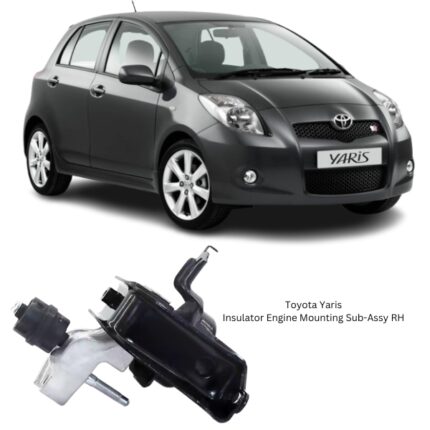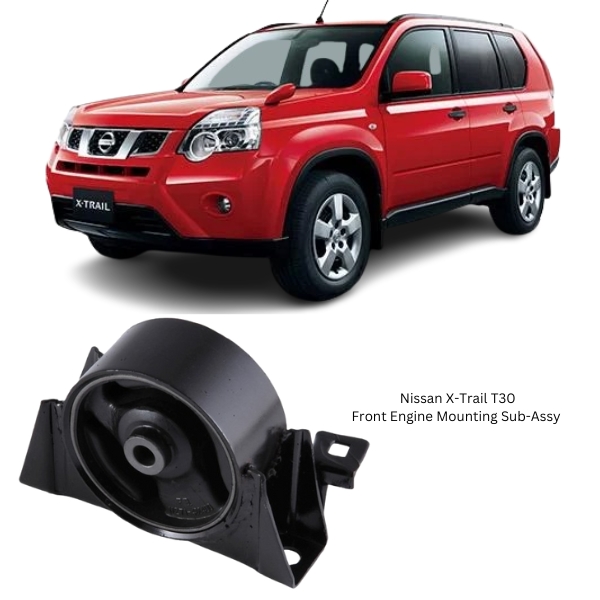Get Nissan X-Trail T30 Front Engine Mounting Sub-Assy 11271-8H310B in Kenya
The Front Engine Mounting Sub-Assembly is a fundamental component in the structure of any vehicle’s powertrain support system. Positioned at the front of the engine, this sub-assembly plays a critical role in maintaining the engine’s structural alignment, minimizing vibration, and reducing stress on surrounding systems. It connects the engine to the vehicle’s subframe or chassis, absorbing both static loads and dynamic forces during vehicle operation.
Engine mounts are designed to handle continuous stress from torque, weight, and vibration while isolating these forces from the cabin. The Front Engine Mount Sub-Assy, in particular, is tasked with absorbing forward engine motion and controlling engine movement during acceleration, braking, and shifting. It also plays a vital role in the alignment of the engine and transmission to the driveline components.
Primary Function and Purpose
The Front Engine Mounting Sub-Assembly serves several essential functions:
-
Structural Support
It holds part of the engine’s weight and ensures the engine stays in place under all driving conditions. Positioned at the front, it complements side and rear engine mounts by handling longitudinal engine movement. -
Vibration Isolation
The mount helps isolate engine-generated vibrations, preventing them from being transferred to the vehicle frame or cabin. This contributes to overall driving comfort and a quieter ride. -
Torque Reaction Control
During engine operation, torque causes rotational forces that can lead to unwanted movement. The front mount absorbs this motion and prevents excessive rocking or shifting. -
Engine Alignment and Stability
The mount ensures proper alignment of the engine with other drivetrain components such as the transmission and driveshaft. Misalignment can cause wear and performance issues. -
Protection of Ancillary Components
By stabilizing the engine, the mount helps protect wiring harnesses, hoses, belts, and other connected components from undue stress and wear.
These combined functions make the Front Engine Mounting Sub-Assy essential for smooth engine operation and vehicle handling.
Design and Construction
The Front Engine Mount Sub-Assembly is built with durability and flexibility in mind, utilizing materials and design features that enable it to support weight while absorbing vibrations.
Key Components:
-
Metal Housing or Bracket
The outer structure of the mount is typically constructed from forged steel, aluminum, or cast iron, chosen for its high load-bearing capacity and resistance to deformation. -
Rubber or Elastomeric Insulator
A specially formulated rubber compound or synthetic elastomer is bonded between the inner and outer metal housings. This insulator provides cushioning and flexibility, absorbing engine vibrations and movement. -
Central Sleeve or Bushing
A metal sleeve runs through the core of the mount, allowing for bolt insertion and precise connection between the engine and chassis. It enables controlled flexibility and reduces metal-on-metal contact. -
Hydraulic Chamber (in advanced versions)
Some mounts include a hydraulic fluid chamber that further dampens vibration, especially at idle and during gear shifts. Hydraulic mounts are more effective at filtering low-frequency vibrations. -
Corrosion Protection
Metal surfaces are treated with zinc plating, electro-deposition, or powder coating to resist rust, moisture, and chemical corrosion. -
Heat-Resistant Materials
In high-temperature engine environments, heat shields or specially formulated rubber may be added to protect the mount from thermal breakdown.
These components work in harmony to ensure the mount performs under high mechanical and thermal loads without compromising its structural or damping properties.
Performance Features
A properly functioning Front Engine Mounting Sub-Assembly offers a combination of strength, flexibility, and long-term reliability. Its performance features include:
-
Excellent Load Distribution
Supports the front portion of the engine, distributing weight evenly across the engine bay and frame. -
High Vibration Absorption
Damps vibrations at idle and under load, reducing NVH (noise, vibration, and harshness). -
Dynamic Load Resistance
Withstands rapid changes in engine torque and momentum during acceleration and braking. -
Thermal and Chemical Resistance
Maintains its mechanical properties in the presence of oil, coolant, road salt, and high under-hood temperatures. -
Durability Under Stress
Engineered to endure thousands of operating cycles without deformation, cracking, or separation.
These attributes ensure the vehicle’s performance, comfort, and structural reliability remain consistent over the mount’s lifespan.
Symptoms of a Failing Front Engine Mount Sub-Assy
Over time, engine mounts degrade due to fatigue, fluid exposure, and mechanical wear. Common symptoms of a failing front engine mount include:
-
Increased Vibration
If the rubber insulator fails or hardens, engine vibrations will transfer into the cabin, especially at idle. -
Engine Rocking or Movement
A broken or weakened mount allows the engine to shift during acceleration, deceleration, or gear shifts. -
Clunking or Thumping Noise
If the mount no longer holds the engine securely, it may cause knocking sounds as the engine moves excessively. -
Rubber Cracking or Delamination
Visual inspection may reveal splits, cracking, or separation between the rubber and metal components. -
Leaking Fluid (Hydraulic Mounts)
A ruptured hydraulic mount will leak fluid, reducing its ability to absorb vibrations. -
Misalignment of Engine or Transmission
A sagging or collapsed mount can misalign the powertrain, causing drivability issues or damage to connected systems.
Identifying these symptoms early can prevent further mechanical problems and maintain driving safety and comfort.
Installation Overview
Installing a Front Engine Mounting Sub-Assy requires mechanical knowledge and the right tools. The process typically involves:
-
Safety Precautions
Ensure the engine is cool, the battery is disconnected, and the vehicle is securely supported. -
Support the Engine
Use a floor jack with a wooden block or an engine hoist to hold the engine in position while the mount is replaced. -
Remove the Old Mount
Unbolt the mount from the engine and frame. Inspect the surrounding area for wear or damage. -
Install the New Mount
Position the new mount, align it properly, and tighten the bolts to the specified torque. -
Final Inspection
Check engine alignment and perform a test run to ensure there are no unusual noises or vibrations. -
Road Test
A brief test drive helps confirm the engine is stable and vibration levels are within normal range.
Proper installation ensures optimal performance and prevents premature failure.
Benefits of Timely Replacement
-
Restores Powertrain Stability
Keeps the engine firmly in place, improving overall handling and performance. -
Reduces Cabin Vibration and Noise
Enhances driver and passenger comfort by isolating harsh engine motion. -
Prevents Damage to Surrounding Components
Protects hoses, belts, and wiring from stress or misalignment. -
Improves Gear Shift Smoothness
Reduces driveline slack and improves transmission response. -
Maintains Safety and Reliability
Ensures engine containment in sudden stops or impacts.
Follow us on Facebook for more parts.





Reviews
Clear filtersThere are no reviews yet.